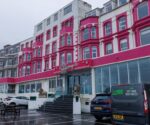The UK island that was once one of the world’s ‘most dangerous’ | UK | Travel
The UK has between 4,400 and 6,000 islands, varying in size, geography and habitation. The main island of Great Britain (which includes England, Scotland and Wales) is of course the largest in the UK.
The overwhelming majority are uninhabited, with only 188 having permanent populations living on them. Scotland boasts the most number of islands out of any country in the UK. Among those lying off its coats are the Hebrides, Orkney, and Shetland archipelagos. A Scottish government report in 2023 listed the country as having 93 inhabited islands, including Skye, Mull and Lewis and Harris.
There are also many more that remain remote and uninhabited. One of those was for decades considered too dangerous to allow public access.
Gruinard Island – or as it is better known “Anthrax Island” – lies off the north west coast of Scotland. It became the centre for a government biological weapons testing programme during World War II, which would make the island inaccessible to visitors for years thereafter.
War time leader Winston Churchill was desperate to develop biological weapons, after fearing that Nazi Germany had already acquired such a capability. The British Prime Minister tasked a team of top scientists with finding a way of weaponising anthrax.
Anthrax is a lethal bacteria, especially when inhaled, and it proves fatal in almost all cases, even with medical treatment. The scientists carried out experiments using live stock in absolute secrecy on the island, with local communities oblivious to the goings-on there.
Over 50 years later, a declassified Ministry of Defence film finally lifted the lid on their activities. In one clip, a small blast set off by remote control produces an anthrax cloud that heads towards 80 sheep. The animals inhaled the anthrax and died within days of their exposure to the lethal toxin. The experiment was deemed a success and the scientists returned to Porton Down – but the anthrax remained.
The island remained contaminated until environmental activists calling themselves Dark Harvest launched an unusual campaign in 1981 to force the government to clear up its mess.
Teams of scientists, vaccinated against anthrax and dressed in protective clothing, descended on the island in 1986 to begin the decontamination process.
It took them fours years to clear the island if any traces of the deadly bacteria. But finally on April 24 1990, Gruinard Island was declared anthrax free.









